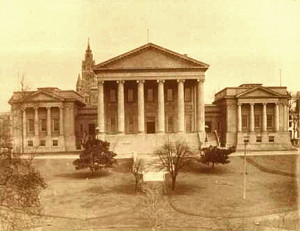 We have an opinion from Virginia’s Attorney General that a statute passed by the Jim Crow General Assembly in 1902-04, and in its various iterations since, protects the offending Confederate soldier statues around the Commonwealth including the confederate soldier statue in Leesburg, erected in 1908, hefting his rifle, pointed toward all persons approaching the County courthouse.
We have an opinion from Virginia’s Attorney General that a statute passed by the Jim Crow General Assembly in 1902-04, and in its various iterations since, protects the offending Confederate soldier statues around the Commonwealth including the confederate soldier statue in Leesburg, erected in 1908, hefting his rifle, pointed toward all persons approaching the County courthouse.
The Attorney General states that “[t]he historical antecedent” was passed by the General Assembly in February 1904, providing that such a monument could not be “disturbed” and had to be “protected.”
The Attorney General in an advisory opinion states that we should make “a careful investigation of the history and facts concerning a particular monument in a given locality.”
Rather, we should investigate “the history and the facts” of the racially intolerant legislators who passed this law in 1902-04, as part of a constitutionally impermissible schema, calculated to offend and suppress blacks in Virginia.
In 1902, our elected representatives with too few dissenters to matter sought “to purify” the ballot box, to chill and bar blacks from exercising the franchise, and to discourage the belief that it was a self-evident truth that all men and women were created equal.
Virginia created a distasteful constitution in 1902 with the express objective of restoring white supremacy.
Presiding over Virginia’s constitutional convention in 1902, John Goode said that the 15th amendment, providing for African American suffrage, was “a stupendous blunder” and “a crime against civilization and Christianity.”
The Virginia convention delegates created their Constitution without allowing a public to ratify it, denying the vote to blacks and providing for a poll tax.
In the next election, in the 1905 governor’s election, there were 88,000 fewer voters.
The dead hand of the KKK, Jim Crow laws, and massive resistance against integration, fully supported by our General Assembly, lives on, even today, with amendments that perpetuate this distasteful legislative relic.
The 13th Amendment to the U.S. Constitution, in Section 1, commanded that “[n]either slavery or involuntary servitude … shall exist within the United States.”
In Jones v. Alfred H. Mayer Co., in 1968, the Supreme Court explained this was not only about stopping slavery, it was also about “abolish[ing] … all badges and incidents of slavery in the United States.”
In R.A.V. v. City of St. Paul, the court considered the “badges” of the 13th Amendment to encompass hate speech. Constitutional scholars have found that the 13th Amendment encompasses sexual exploitation as a badge of slavery, racial profiling, race-based peremptory challenges, racial disparities in capital punishment, environmental degradation of black communities, racial disparity in medical treatments, and confederate symbols.
This suspect statute protecting confederate values contravenes the intent and purpose of those constitutional amendments passed in the sunset of the civil war. State statutes must fall when they contradict the constitution.
It serves us poorly to have a legal opinion, even “advisory,” that memorializes without criticism a statute that is at least unconstitutional by its original intent and as applied.
Let us resolve to take down that statue in Leesburg, and let someone sue the county, if that’s what it takes, so we may litigate the unworthy origin of this statute. Or perhaps we should encourage those aggrieved parties to take the matter to court.
In any case, let us stop pretending that this statute is constitutional, or legally respectable, by its origin.
We are good in Virginia at finding ways to avoid doing what’s right.
This legislation is wrong and pretending otherwise makes us complicit in its original ill-conceived intent.
